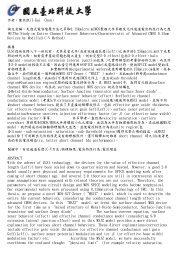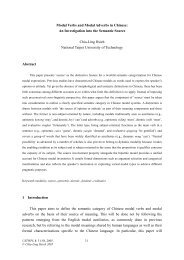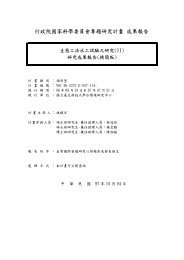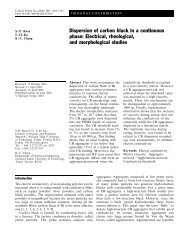Optimal production of sulphuric acid by Thiobacillus thiooxidans ...
Optimal production of sulphuric acid by Thiobacillus thiooxidans ...
Optimal production of sulphuric acid by Thiobacillus thiooxidans ...
You also want an ePaper? Increase the reach of your titles
YUMPU automatically turns print PDFs into web optimized ePapers that Google loves.
1954 H.-L. Liu et al. / Process Biochemistry 39 (2004) 1953–1961<br />
are usually very low [13]. The highest cell and <strong>sulphuric</strong><br />
<strong>acid</strong> concentrations obtained <strong>by</strong> conventional shaking flask<br />
cultivation were about 0.224 g cell/l [14] and 15 000 ppm<br />
[15], respectively, in 8–11 days. Although some researchers<br />
have attempted to improve cell concentration and <strong>sulphuric</strong><br />
<strong>acid</strong> <strong>production</strong> <strong>by</strong> various approaches [16,17], they were<br />
still insufficient and the cultivation time too long. Cell<br />
growth and <strong>sulphuric</strong> <strong>acid</strong> <strong>production</strong> are considered to be<br />
mainly limited <strong>by</strong> substrate deficiency and the accumulation<br />
<strong>of</strong> inhibitory metabolites [14,18,19]. The above facts<br />
strongly limit the industrial application <strong>of</strong> T. <strong>thiooxidans</strong> for<br />
bioleaching <strong>of</strong> heavy metals from sulphide ores.The effects<br />
<strong>of</strong> various nutritional and environmental factors have been<br />
studied to enhance the cell concentration and <strong>sulphuric</strong> <strong>acid</strong><br />
produced <strong>by</strong> T. <strong>thiooxidans</strong>. The conventional method <strong>of</strong><br />
medium optimisation involves changing one variable at a<br />
time, keeping the others at fixed levels. Being single dimensional,<br />
this laborious and time-consuming method <strong>of</strong>ten does<br />
not guarantee determination <strong>of</strong> optimal conditions [20–22].<br />
In addition, carrying out experiments with every possible<br />
factorial combination <strong>of</strong> the test variables is impractical because<br />
<strong>of</strong> the large number <strong>of</strong> experiments required. Unlike<br />
conventional optimisation, statistical optimisation methods<br />
can take into account the interactions <strong>of</strong> variables in generating<br />
process responses [23]. Response surface methodology<br />
[24], an experimental strategy for seeking the optimum<br />
conditions for a multi-variable system, is a much more efficient<br />
technique for optimisation [20]. This method has been<br />
successfully applied to the optimisation <strong>of</strong> medium composition<br />
[25,26], conditions <strong>of</strong> enzymic hydrolysis [27], parameters<br />
<strong>of</strong> food preservation [28] and fermentation process<br />
[25].<br />
The capability <strong>of</strong> bioleaching <strong>of</strong> heavy metals <strong>by</strong> T. <strong>thiooxidans</strong><br />
is directly associated with <strong>sulphuric</strong> <strong>acid</strong> <strong>production</strong><br />
<strong>by</strong> this microorganism. Thus, the aim <strong>of</strong> this work was to<br />
apply fractional factorial design to optimise the fermentation<br />
medium for <strong>sulphuric</strong> <strong>acid</strong> <strong>production</strong> <strong>by</strong> an indigenous<br />
T. <strong>thiooxidans</strong> in shake flask experiments.<br />
2. Materials and methods<br />
2.1. Microorganisms<br />
The T. <strong>thiooxidans</strong> used throughout this study was obtained<br />
from sewerage samples from a sulphate-contaminated<br />
site near Keelung, Taiwan. Isolation experiments were<br />
undertaken at pH 4.0 to imitate a favourable in situ condition<br />
from an ecological perspective. Successful enrichment<br />
cultures on elemental sulphur should exhibit a decreasing<br />
pr<strong>of</strong>ile in pH and biased amplification <strong>of</strong> sulphur-oxidizing<br />
bacteria, leading to high purity <strong>of</strong> T. <strong>thiooxidans</strong>. The abundance<br />
<strong>of</strong> T. <strong>thiooxidans</strong> was obtained <strong>by</strong> inoculating sewerage<br />
dilutions into T. <strong>thiooxidans</strong> optimum growth medium<br />
(T. <strong>thiooxidans</strong> OGM) (N : P = 5 : 1; compositions:<br />
(g/l) KH2PO4 = 1.0, (NH4)2SO42.54, MnSO4 = 0.02,<br />
MgSO 4 = 0.1, CaCl2 = 0.03, FeCl3 = 0.02, powdered<br />
S 0 = 2.0, nystatin = 0.1; pH 4.0). The inoculated culture<br />
was then incubated in a water-bath shaker at 30 ◦ C,<br />
125 rpm. Sulphate, biomass concentrations and pH level<br />
were measured over time for consecutive subcultures. Pure<br />
T. <strong>thiooxidans</strong> isolates were obtained after seven consecutive<br />
subcultures and maintained for subculture in shaker<br />
flasks at 30 ◦ C, 125 rpm before being used.<br />
2.2. Analytical methods<br />
Sulphate content was determined according to the “Turbidimetric<br />
Method” as described in Standard Methods [29].<br />
Aliquots <strong>of</strong> 10 ml were drawn from the culture and filtered<br />
through a general grade filter paper (Advantec, Tokyo,<br />
55 mm). The turbidity was read at wave length <strong>of</strong> 450 nm<br />
against a blank containing deionised/distilled (DI/DD)<br />
water. The turbidity reading was taken within 10–15 s.<br />
The concentrations <strong>of</strong> <strong>sulphuric</strong> <strong>acid</strong> were measured <strong>by</strong><br />
DR/2000 spectrophotometer (HACH, Loveland, CO, USA).<br />
Absorbance at 620 nm was compared with general gravimetric<br />
results to obtain a calibration curve [30]. By reading<br />
the turbidity <strong>of</strong> a given sample culture, if necessary the<br />
sample has to be diluted to a proper concentration range<br />
for the measurement, the corresponding amount <strong>of</strong> biomass<br />
was obtained (1.00 OD620 nm ∼ = 0.98 ± 0.08 g/l dry cell<br />
weight). Using pH 4.0 and 10.0 standard buffers (Fisher<br />
Scientific, Tokyo, Japan) for calibration, standard measurement<br />
<strong>of</strong> pH was undertaken using pH electrode and meter<br />
(Cole-Parmer, Vernon Hills, IL, USA) with an accuracy<br />
0.1 pH unit.<br />
2.3. Experimental design and optimisation <strong>by</strong> response<br />
surface methodology<br />
A full-factorial design, a powerful tool for understanding<br />
complex processes and for describing factor interactions in<br />
multi-factor systems, has been well described previously<br />
[22,31]. The medium composition resulting in the highest<br />
<strong>production</strong> <strong>of</strong> biomass was considered as the basal medium,<br />
and used for the optimisation <strong>by</strong> response surface methodology<br />
(RSM) using central composite design (CCD). RSM<br />
[23] is an empirical statistical technique employed for multiple<br />
regression analysis using quantitative data obtained<br />
from properly designed experiments to solve multi-variable<br />
equations simultaneously. A second-order RSM experiments<br />
using a five-level CCD were used to explore the<br />
effects <strong>of</strong> various medium ingredients on <strong>production</strong> formation.<br />
The range and the levels <strong>of</strong> the variables investigated<br />
in this study are given in Table 1. Each factor in the design<br />
was studied at five different levels (−2, −1, 0, 1, 2). All<br />
variables were taken at a central coded value considered<br />
as zero.<br />
In this case, a 2 4 full factorial central composite design for<br />
four independent variables each at five levels with eight star<br />
points and six replicates at the centre points was employed








